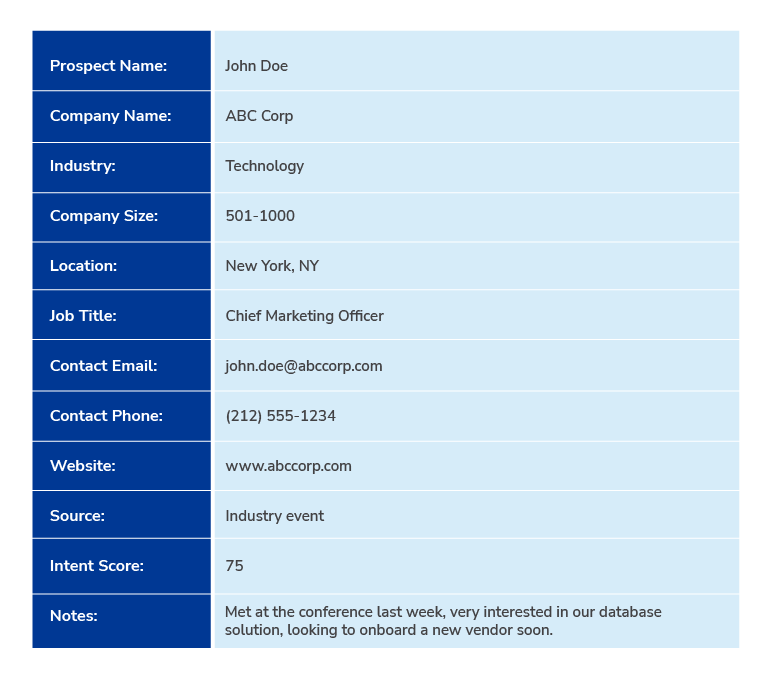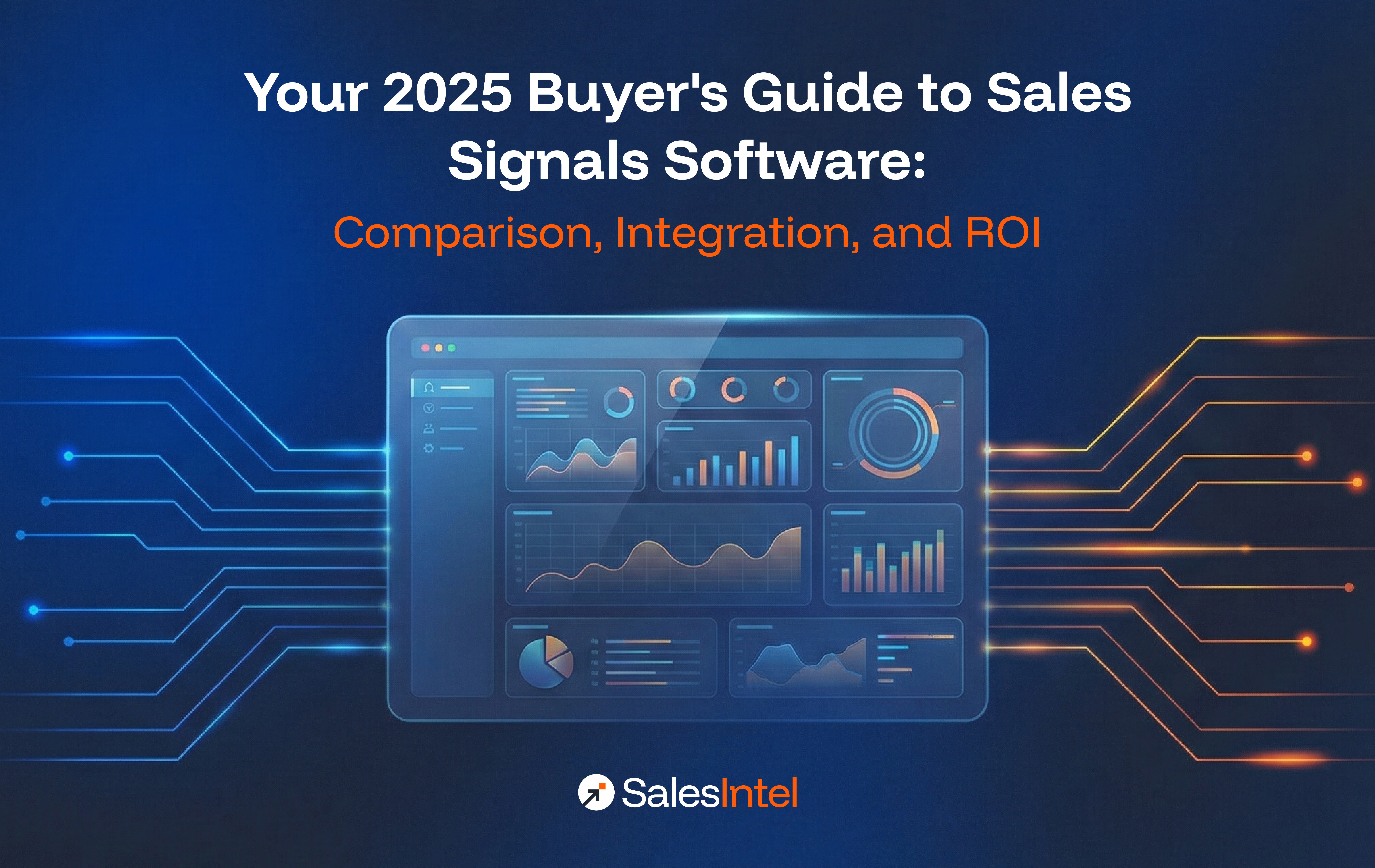In sales, your success heavily relies on your ability to identify and connect with the right people at the right accounts. Whether you’re a seasoned sales professional or just starting out in the field, you’re likely no stranger to prospecting (and if you are new to this, welcome, we’re glad you’re here!).
Instead of waiting for inbound leads to come to you, outbound prospecting allows you to take a proactive role in the sales process while increasing brand awareness among your ideal customers – planting the seed for future consideration, and positioning your company as a trusted solution provider.
However, modern sales prospecting does not mean simply cold calling random businesses day after day hoping to find one in the market for your product or service. In fact, doing that is a surefire way to burn yourself out by making countless dials and hearing some “colorful” rejections.
That’s where a prospect list comes in.
A well-defined prospect list serves as the cornerstone of your outreach efforts, guiding you toward the most promising leads and maximizing your chances of closing deals.
In this guide, we’ll cover everything you need to know about sales prospect lists. We’ll explain what prospect lists are, how they work, and best practices for building a high-quality list that will fuel your sales pipeline and drive revenue growth.
What is a Sales Prospect List?
A sales prospect list is a catalog of companies that fit your ideal customer profile (ICP) and the contacts within those companies who are most likely in the market for your solutions.
As a salesperson, you’re the “bounty hunter” of the organization. Your job is to go out and bring back revenue, or “bounties”. Think of your prospect list like the “wanted” posters in an old western saloon. Prospect lists are like these wanted posters on a massive scale.
“WANTED — Director-level marketer at Intel”
“BOUNTY — An enterprise deal”
A well-researched and segmented list tells you exactly where to go in your outbound efforts and increases the likelihood of connecting with prospects who have a genuine interest in your offering. By focusing your sales efforts on a targeted list of qualified prospects, you can be more efficient and productive in your sales activities and avoid wasting your time and resources chasing after out-of-market leads that are unlikely to convert.
What Are the Best Prospecting Methods?
Now that we’ve covered what prospect lists are and why they’re important, let’s talk about how to build on yourself. Here are a few of the most effective methods for building a rock-solid prospect list.
Ideal customer (or client) profile (ICP):
This is the first step in building a prospect list. Your ICP helps you understand who your best customers are and who would benefit most from your products and services. If you already have a well-defined ICP, that’s great, you’re well on your way! If not, check out our Detailed Guide to Building Your Ideal Customer Profile to learn how it’s done.
Referrals:
Referrals are far and away the most powerful influencing factor on any purchase decision. Research has shown that between 88%-92% of consumers trust recommendations from their friends and family. Asking existing (happy) customers and business colleagues for introductions or referrals to companies within their network can provide warm introductions to potential new clients, increasing the chances of engagement and conversion. While these relationships take time to develop, they are well worth the effort!
Intent data:
Intent data is one of the most effective ways to build a list of potential prospects actively researching solutions like yours and in the market to make a purchase. The beauty of intent data is that it allows you to proactively engage with interested buyers early in their research process before they have reached out to your competitors – giving you a unique opportunity to build brand trust and ensure a seat at the table when they are ready to buy.
Business-oriented social media platforms like LinkedIn can be valuable sources for you to identify and engage with potential prospects within your ICP companies, connect with decision-makers, and initiate conversations. For some advanced tips and tricks for LinkedIn prospecting, read about the 10 Best Ways to Use LinkedIn for Sales Prospecting.
Networking Events:
As much as the world has gone digital over the past decades, sometimes there is no alternative to face-to-face interaction. Attending relevant industry events, conferences, and trade shows provides opportunities to connect with potential prospects face-to-face, gather valuable insights, and build relationships with your future customers.
Sales Prospecting Tools:
While the methods we’ve covered so far are effective for building prospect lists, they can be somewhat time-consuming. Sales prospecting tools handle all of the manual research and legwork for you and deliver a fully built prospect list based on your needed criteria. Platforms like SalesIntel use firmographics and technographics to segment your audience, and layer on intent data to deliver a prospect list of interested buyers that are highly likely to be in the market for your solutions.
The most effective prospecting strategy often combines multiple methods, tailored to your specific industry, target audience, and sales cycle. As a sales professional, you should continuously experiment, measure, and refine your prospecting approaches to optimize your efforts and drive better results.
What Information Should You Include in a Prospect List
While the exact criteria you decide to include in your prospect list will vary depending on the type of product or service you provide, your target audience, and your industry, in general, your prospect list should include as much relevant information as possible about each person.
Here are some elements of a good list that will make prospecting much easier for you.
- Contact details (name, title, email, phone)
- Firmographics (company name, industry, size, location)
- Source (how you identified or obtained the prospect)
- Intent score (online behaviors indicating interest in your products/services)
- Prospect notes (additional details, interactions, or follow-up actions)
Here’s what a sample prospect list entry could look like:

Using this information, you’ll have the best possible chance of reaching your prospect with highly personalized outreach messages that speak to exactly what they are looking for.
Prospect Lists and Compliance
Before you get started building your list, we have to talk about data privacy. With consumer privacy at the forefront of everyone’s mind, governments have enacted laws and regulations that limit the collection, sale, and use of personal data for companies.
The GDPR applies to any organization that processes or holds the personal data of individuals residing in the European Union (EU). This law sets strict guidelines on how you should collect, store, and use personal data, with hefty fines for non-compliance.
Similarly, if you operate in California, the CCPA grants consumers certain rights regarding their personal information, including the right to know what personal data you’re collecting, the right to have their data deleted, and the right to opt out of the sale of their personal information.
- Obtain Explicit Consent: Before collecting or processing personal data, ensure that you have obtained explicit consent from individuals. This means providing clear and transparent information about how you will use their data and offering them the choice to opt-in or opt-out.
- Respect opt-out requests: If a prospect requests to opt out of further communications or to have their personal data deleted, it’s critically important to respect their request and remove them promptly. The last thing you want is to continue sending emails to someone who has already opted out.
- Limit data collection: Only collect personal data necessary for your prospecting efforts and avoid collecting excessive or irrelevant information. If you want more data points on your prospects, data enrichment services can provide additional prospect information without having to collect it yourself.
- Disclose Data Practices: Be transparent about your data collection and processing practices. Provide clear and accessible privacy policies that clearly explain how you handle personal data so there are no surprises for your prospects when you do reach out.
Complying with any and all regulations is not only the legally responsible thing to do when building your prospect list, but it also ensures that your company maintains a good reputation among buyers.
Common Sales Prospecting Mistakes to Avoid
Prospecting is a delicate balance of art and science, requiring a combination of research, personalization, and persistent follow-up. However, even sales industry veterans can fall victim to common mistakes that can undermine their efforts and hinder their ability to effectively engage with potential customers. Here are a few common mistakes to avoid in your prospecting journey:
- Lack of Research and Personalization: If you’ve ever been on the receiving end of a blatantly generic outreach email, you know just how bad they make a salesperson (and company) look.
“Dear business owner, it looks like your company does advertising. Do you have 15 minutes to talk about how we can help with lead gen?”
Failing to adequately research your prospects and tailor your outreach, shows a lack of effort and may appear generic and impersonal, leading to low engagement and poor response rates.
- Relying on Outdated or Inaccurate Data: Even the best and most personalized outreach email will go unanswered if sent to the wrong person. Using outdated or incorrect prospect information can undermine your prospecting efforts, leading to wasted time, energy, and resources. Using a data provider with accurate contact data can prevent this mistake, and help ensure all of your hard work isn’t squandered.
- Focusing Quantity Over Quality: Would you rather book 10 meetings per month from 100 outreaches or 11 meetings from 1000? Prioritizing the sheer number of prospects over their quality and fit can result in a high volume of unqualified leads, lowering your conversion rates and leaving you burnt out. Instead, focus on outreach to a lower number of more qualified prospects.
- Inadequate Follow-Up: In SaaS sales, it can take up to four no’s before one “yes”. Neglecting to follow up with prospects in a polite yet persistent manner can result in you losing opportunities and potential customers slipping through the cracks.
- Neglecting Nurturing: If and when you do get a response from a prospect, your work isn’t done yet. Treating prospecting as a one-time event instead of nurturing leads through consistent, targeted communication can cause prospects to lose interest in what you’re offering or go cold once you’ve connected. If a prospect does respond, keep nurturing them until they convert.
- Relying on a Single Channel: Depending solely on one prospecting channel, such as cold calling or email, can limit your reach and prevent you from engaging prospects through multiple touchpoints. If your phone calls are going unanswered, try reaching out on LinkedIn or via email. If that’s not working, you can also try sending a little gift or finding them at an in-person event. The more channels you use to engage with your prospects, the greater chance you’ll have of finally making that connection.
- Ignoring Compliance and Data Privacy Regulations: As we’ve said before, disregarding data privacy regulations, such as GDPR and CCPA, can lead to legal consequences for you and damage your brand’s reputation. Make sure you’re complying with all applicable data privacy laws and regulations for your and your prospects’ geographic region.
- Lack of Tracking and Measurement: You can’t improve what you don’t measure. Failing to track and measure the effectiveness of your prospecting efforts can make it difficult for you to identify areas for improvement and optimize your outbound strategy.
By being aware of (and avoiding) these common mistakes, you can substantially improve the effectiveness of your prospecting efforts and increase engagement rates with prospects..
The Path to Building a Powerful Prospect List
A well-crafted and meticulously built sales prospect list will not only save you from chasing out-of-market buyers but also will allow you to focus your energy on only the people who are most likely to engage with your outreach and eventually convert.
By leveraging the list-building methods we’ve discussed, maintaining the highest standard of privacy compliance, and avoiding common prospecting mistakes, you’ll be able to maximize your outreach effectiveness, increase engagement rates, and ultimately drive better results and revenue growth for yourself and the rest of your sales team.
If you’d like to learn more about how you can use SalesIntel’s sales intelligence platform to build a winning prospect list, get a personalized demo today!




